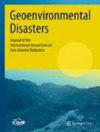将层次分析法与机器学习算法逐步整合,用于喀麦隆北蒙戈周边地区的滑坡、沟壑侵蚀和山洪易感性测绘
IF 4
Q2 ENVIRONMENTAL SCIENCES
引用次数: 0
摘要
喀麦隆火山线(CVL)是一个海洋-大陆巨型构造,极易发生滑坡/泥石流、沟壑区侵蚀和山洪暴发等地质灾害。最近的地理空间实践提倡一种由人工智能支持的多危害分析方法。本研究通过将分析层次分析法(AHP)与机器学习(ML)相结合,在北蒙戈周边(喀麦隆沿海地区)提出了多重地球环境灾害易感性(MGHS)工具。方法利用卫星影像、全球地理数据库和野外调查资料,构建24个因子。利用容差系数(TOL)和方差膨胀因子(VIF)量化了各因子之间的多重共线性关系。利用AHP系数对各因素进行加权,并通过加权线性组合法(WLC)得到各地质环境灾害的初步图。根据事件记录和分析人员的知识进行抽样,使用Google Earth Engine (GEE)云计算接口进行分类。使用分类回归树(CART)、随机森林(RF)和梯度增强回归树(GBRT)作为堆叠危险因素的基本学习器,使用支持向量回归(SVR)进行元学习。结果根据层次分析法,降雨是所有地质环境灾害的最高触发因素,其触发系数为1,而学习后重要性评价差异较大。接受者工作特征下面积(AUROC/AUC)均大于0.96,基本分类器的f1 -得分在[0.86-0.88]之间。滑坡、沟壑区侵蚀和山洪在空间上呈现出不同的分布特征,从而证实了它们共现的可能性。MGHS输出清楚地显示两个和三个同时发生的事件。最后,使用种群层和SVR输出评估的人类脆弱性表明,以Nkongsamba提取物为例,高浓度的人类暴露程度最高。结论将AHP与单一学习者结合,再结合元学习者,可以有效地模拟MGHS和相关的人类脆弱性。下一步是地质环境灾害之间的相互作用,建议市议会将结果纳入规划过程。本文章由计算机程序翻译,如有差异,请以英文原文为准。
Stepwise integration of analytical hierarchy process with machine learning algorithms for landslide, gully erosion and flash flood susceptibility mapping over the North-Moungo perimeter, Cameroon
Abstract Background The Cameroon Volcanic Line (CVL) is an oceanic-continental megastructure prone to geo-hazards, including landslide/mudslide, gully erosion and flash floods targeted in this paper. Recent geospatial practices advocated a multi-hazard analysis approach supported by artificial intelligence. This study proposes the Multi-Geoenvironmental Hazards Susceptibility (MGHS) tool, by combining Analytical Hierarchy Process (AHP) with Machine Learning (ML) over the North-Moungo perimeter (Littoral Region, Cameroon). Methods Twenty-four factors were constructed from satellite imagery, global geodatabase and fieldwork data. Multicollinearity among these factors was quantified using the tolerance coefficient (TOL) and variance inflation factor (VIF). The AHP coefficients were used to weigh the factors and produce a preliminary map per Geoenvironmental hazard through weighted linear combination (WLC). The sampling was conducted based on events records and analyst knowledge to proceed with classification using Google Earth Engine (GEE) cloud computing interface. Classification and Regression Trees (CART), Random Forest (RF) and Gradient Boosting Regression Trees (GBRT), were used as basic learners of the stacked hazard factors, whereas, Support Vector Regression (SVR), was used for a meta-learning. Results The rainfall was ranked as the highest triggering factor for all Geoenvironmental hazards according to AHP, with a coefficient of 1 , while the after-learning importance assessment was more varied. The area under receiver operating characteristic (AUROC/AUC) was always more than 0.96 , and F 1 -score is between [ 0.86–0.88 ] for basic classifiers. Landslides, gully erosion and flash floods showed different spatial distributions, confirming then their probability of co-occurrence. MGHS outputs clearly displayed two and three simultaneous occurrences. Finally, the human vulnerability assessed with population layer and SVR outputs showed that high human concentrations are also the most exposed, using the example of Nkongsamba’s extract. Conclusions Combining AHP with single learners, then a meta-learner, was efficient in modelling MGHS and related human vulnerability. Interactions among geo-environmental hazards are the next step and city councils are recommended to integrate results in the planning process.
求助全文
通过发布文献求助,成功后即可免费获取论文全文。
去求助
来源期刊

Geoenvironmental Disasters
Social Sciences-Geography, Planning and Development
CiteScore
8.90
自引率
6.20%
发文量
22
期刊介绍:
Geoenvironmental Disasters is an international journal with a focus on multi-disciplinary applied and fundamental research and the effects and impacts on infrastructure, society and the environment of geoenvironmental disasters triggered by various types of geo-hazards (e.g. earthquakes, volcanic activity, landslides, tsunamis, intensive erosion and hydro-meteorological events).
The integrated study of Geoenvironmental Disasters is an emerging and composite field of research interfacing with areas traditionally within civil engineering, earth sciences, atmospheric sciences and the life sciences. It centers on the interactions within and between the Earth''s ground, air and water environments, all of which are affected by climate, geological, morphological and anthropological processes; and biological and ecological cycles. Disasters are dynamic forces which can change the Earth pervasively, rapidly, or abruptly, and which can generate lasting effects on the natural and built environments.
The journal publishes research papers, case studies and quick reports of recent geoenvironmental disasters, review papers and technical reports of various geoenvironmental disaster-related case studies. The focus on case studies and quick reports of recent geoenvironmental disasters helps to advance the practical understanding of geoenvironmental disasters and to inform future research priorities; they are a major component of the journal. The journal aims for the rapid publication of research papers at a high scientific level. The journal welcomes proposals for special issues reflecting the trends in geoenvironmental disaster reduction and monothematic issues. Researchers and practitioners are encouraged to submit original, unpublished contributions.
 求助内容:
求助内容: 应助结果提醒方式:
应助结果提醒方式:


